Power Up Your Sit To Stand: Chair Yoga To Improve Mobility
Standing up and sitting down-we may do this task multiple times a day and we probably don’t even think about it. That is, until we have difficulty. The task of standing up and sitting down involves multiple different muscles and joints in the lower body and the core. We may also use our arms to assist in standing up and sitting down safely as well. We may perform this movement countless times throughout our lifetime. The ability to stand up and sit down safely is one task marker for independence. It has a number of important ramifications in the ability to complete activities of daily living- as well as activities of leisure. Keep reading for more information, some tips, and a chair yoga routine.
This post contains affiliate links. I earn from qualifying purchases. This means that I may earn a commission should you choose to sign up for a program or make a purchase using my link. This is at no extra cost to you. I only recommend products that I truly believe are helpful. See our Privacy Policy and Disclosures page.
It is a complex task and it is a task of power. We most definitely require adequate range of motion in multiple joints, however muscle strength is one of the biggest determining factors in the ability to complete this most functional task. In a nutshell, the task of sitting to standing involves the ability to get our center of gravity forward and bear weight through our lower extremities. We can use chair yoga to improve mobility. If you are looking for a chair routine video, scroll to the bottom.
I have previously mentioned that hand grip strength is a marker for overall independence and morbidity-All About the Upper Body. You can take a look at this study if you are interested in learning more about the effect of grip strength on sit to stand or to read more about the research surrounding this task. Then keep reading for some reasons why standing up may be difficult and some chair yoga poses to help.
As a side note, if you have a medical condition or have difficulty finding supportive shoes that work for you, you may be interested in taking a look at ICS Shoes. They specialize in extra wide, comfort, orthopedic, and diabetic shoes. Here is a link to an example of a walking shoe: Women’s Xelero Genesis Sneaker Shoe
5 Reasons Standing Up May be Difficult
At some point, we may notice that it is becoming a little more difficult to complete this task. Maybe we find that we are moving a little slower, it takes a bit more effort, or we feel it in our joints. Maybe we will start to use our upper body to help. Possibly it takes more than one attempt to complete this task. If you are having difficulty completing the tasks of sitting to standing or it is requiring multiple attempts, there are a number of things that may be contributing to this. Here are a few possibilities:
1.Muscle weakness
Muscle weakness in the lower extremities and core (or upper body if you are using your arms). We may think of the big muscles in the thighs and the glutes, but we also need strength in our ankles -especially the muscles in the front of our foot/ankle.
2.Impaired range of motion
A decrease in the range of motion in the ankle, knee, or hip may be affecting our body mechanics.For best body mechanics, we need to have our feet back underneath us a bit and this requires knee flexion beyond 90 degrees and ankle dorsiflexion beyond neutral.
3.Impaired sensation
Impairments in the sensation of the feet may be a cause for difficulty. Always see your healthcare provider right away for any changes in sensation. However if we have a medical condition that results in decreased sensation, we will need to ensure that we are being mindful of your body mechanics and sequencing of this task.
4.Spasticity in the foot or thigh muscles
Spasticity can result in the inability to plant the foot firmly on the ground or to keep the thigh muscle from straightening when you want it to flex. This could be a result of a stroke or other medical condition. Here, individual body mechanics will play a role in making this task more accessible.
5.Fear of falling
Fear is a big factor in being able to complete the sit to stand task. If we have had falls in the past it can be very hard to get that center of gravity forward where it needs to be. We may resist that forward momentum because it doesn’t feel safe to us. This will result in difficulty in getting out of the chair and could be the reason we fall back in the chair when attempting to stand up.
We can use regular yoga chair routines and poses to address some of the range of motion and muscle weakness issues- as well as help us be more mindful. However, if you have recently developed difficulty with this task or it is impairing your function and independence- make sure to see your healthcare provider as soon as possible to determine any specific causes.

How Can We Improve Our Sit To Stand With A Simple Chair Yoga Routine?
There are many chair yoga routines and other videos on YouTube that deal with this issue- take a quick search if that is of interest to you. I try to provide exercises that can be done as independently as possible-if you need help always have someone with you before trying out those exercises. First, let’s take a look at some tips for completing this task:
Sit to Stand:
- First, scoot forward in the seat toward the edge of the chair (Tip: If your hips are lower than your knees, your chair is too low).
- Second, plant the feet parallel and hip width apart to have a stable base upon rising.
- Position the feet slightly back so the knees are bent slightly more than 90 degrees (so you can push through the heels as you stand).
- Hinge forward at the hips and position the nose over the toes.
- Use forward momentum as you lean forward and push through the heels, straightening the knees and hips as you rise up.
- If needed, place your hands on the armrests and straighten the elbows as you push off the chair. Be aware that we get significantly more quadriceps activation when we do not use our arms. You may want to try it first without the arms if able (or try to work up to that).
- To sit down, ensure that the back of your legs are touching the chair.
- Hinge at the hips as you bend the hips (not the waist) and knees and slowly lower to the chair. Reach back for the armrests of the chair as needed.
So this task may not be as simple as just following the above tips. I also understand there are many different variables that are unique to you or someone you care for- such as cognitive issues, fused joints, hemiplegia, use of multiple types of assistive devices, or pain issues. In that case, I highly recommend you see your healthcare provider or a physical or occupational therapist.
As a side note, if you find that it is hard to get into a routine of regular exercise, sit to stand is a great functional exercise to add in during the day. Take a look here if you are interested in learning a few functional exercises.
Chair Yoga Routine For Improving Sit To Stand
If it is right for you, you can get started with improving your range of motion and strength with some chair yoga poses and exercises. Try these 5 simple exercises to help strengthen the muscles needed to complete the sit to stand with more ease. We have visited these poses in previous featured poses posts-so they may look familiar.
(You do not need to do it all everyday- pick 2 of them and do quality repetitions. It is recommended to always consult with you healthcare provider before beginning this or any exercise program. Always stop immediately if you have pain or shortness of breath. Always listen to your body and do what is right for you. The repetitions are suggestions. Quality is always better than quantity.)
For all the poses, begin seated in Mountain Pose:
- Begin seated with a long spine with your feet planted evenly on the ground.
- Thighs are parallel and hip distance apart.
- Chest is broad and shoulders are down and away from the ears.
- Sit back in the chair at any time that you need the support.
1.Ankle Dorsiflexion
- Leaving the heels on the floor, bring the toes up and then place them back down. Try to get as much of the foot off the floor as possible.
- You may choose to hold this position for a breath before lowering the toes back down.
- Complete up to 20 repetitions or as desired.

2.Hip Hinge
- Inhale as you sit tall and lengthen the spine.
- On an exhale, hinge forward a few inches from the hip creases.
- The spine remains long, the chest is open, and the core is engaged.
- Take a 2-3 breaths here.
- On an exhale, hinge at the hips and return back to neutral.
- Complete 5-8 repetitions or as desired.
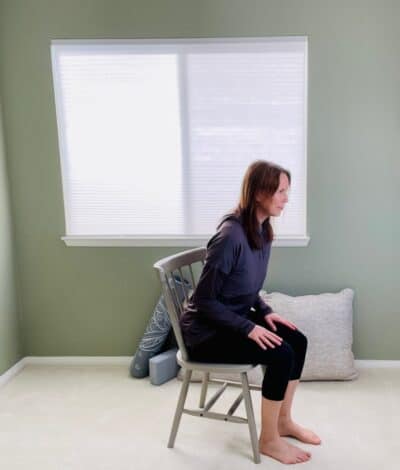
3. Straight Leg Raise
- If able, scoot forward in your seat so that you can extend one knee and place the heel on the floor.
- Inhale to a long spine as you raise the straightened leg up to the height of the opposite knee.
- If able, hold here for one breath as you contract the thigh muscle.
- Exhale as you release the heel back to the floor with control (knee stays straight).
- Repeat 5-10 times or as able.
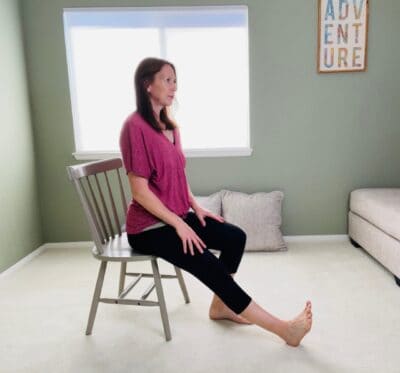
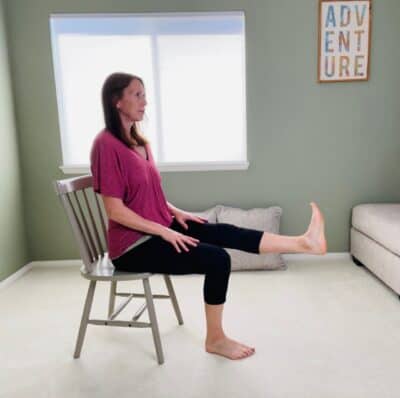
Modification #1
If you need to sit back in the chair, extend one knee in our half staff pose.
With the knee extended, try to lift the leg up 1-2 inches- spine stays long, do not round through the upper back.
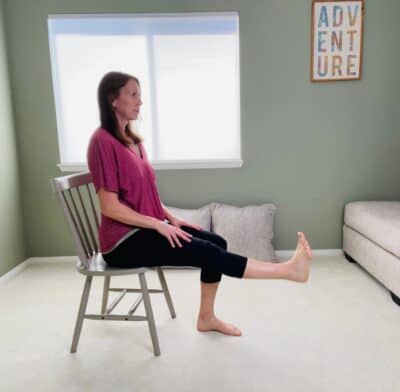
Modification #2
Sit all the way back in the chair and inhale as you slowly extend one knee (thigh stays on the chair).
Hold this position as you contract the thigh muscles. Stay here for a count of 5 as you inhale and exhale.
On an exhale, slowly release the foot to the ground. Repeat 5 times as able. Repeat on the other side.
4. High and Low Lunge
- Begin seated in Mountain Pose with a long spine.
- Ground down through one foot to stabilize and engage the core.
- Inhale as you straighten the opposite knee.
- Exhale to bend the knee and release the foot down to the floor.
- Inhale to raise that same knee up towards the sky.
- Exhale to gently release the foot down to the floor.
- Repeat 5-6 times or as desired.
- Repeat on the other side.

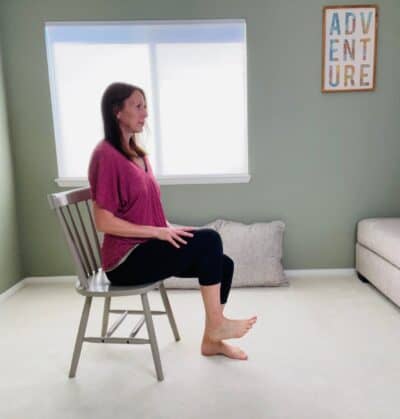
5. Chair Pose
- Begin seated with a long spine. If you are able, sit forward in the chair.
- Ground down through all four corners of your feet and your pelvis to stabilize and bring awareness to the core and abdominal muscles.
- Inhale as you lengthen from the base of the spine to the crown of the head.
- Exhale as you hinge forward from the hips (not bending at the waist), spine remains long and chest broad.
- You may choose to keep the hands on the thighs, or extend them forward.
- Push through the heels to activate the muscles in the legs.
- Stay here for 2-3 breaths as you continue to lengthen the spine and reach the hands forward (important for the forward momentum)
- On an exhale, release the arms to the thighs and hinge at the hips to return to neutral.
- You may choose to rise up out of the seat if that is right for you today.
- Repeat 2-3 times or as desired.
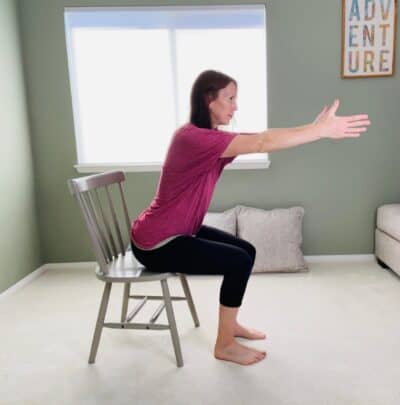
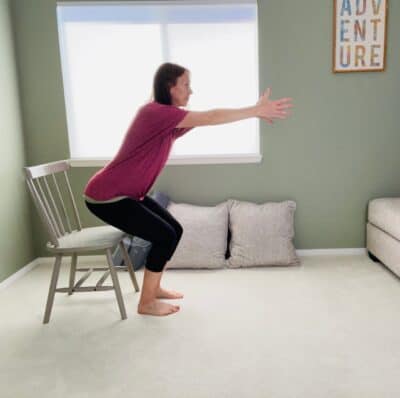
7 More Tips To Improve Sit To Stand
- As I mentioned before, using the arms takes away from that quad activation- but it is not always possible to complete without the arms- extend the arms behind the body, place the hands on the armrests and bend the arms behind you. Straighten the elbows as you push off the chair-keeping your weight forward is key.
- Increase the height of the seat with a firm cushion.
- Add a raised toilet seat in the bathroom.
- If sitting on a low sofa, sit on the end and not the middle in case you require the use of the arm rest to help.
- Recliner lift chairs can be a way to increase independence and can help solve a lot of issues. However- we lose out on that muscle activation. They train the body to shift posteriorly. Over time we will lose the ability to shift our weight forward – and thus have less of an ability to get our center of gravity forward. Also, if you stand up using your arms- you will lose out on activating the triceps muscle. If you do decide to use a recliner lift chair, make sure that you think about those things. If standing up a few times a day and walking around the home is the main form of exercise- we can lose out on that strengthening component.
- It is a good idea to take a moment upon rising to ensure that you have your balance and to make sure that your blood pressure has not decreased upon standing before moving. Stay near the chair as you take a breath and count to 10 before you start moving.
- And as always, take a few deep breaths. If you are finding it difficult and it is taking multiple attempts to stand, take 3 deep breaths to reset. Visualize yourself standing up. Check in with your body mechanics. Relax tense muscles that do not need to be tense- neck, jaw, shoulders- and try it again.
I hope that you found something useful here. Let me know how it goes!
Want More?
Check out this shoe lacing guide from ICS Shoes if you are interested in ways to lace your shoes for the perfect fit: Shoe Lacing For The Perfect Fit
For a video demonstration of the above exercises, take a look at Chair Yoga To Improve Sit To Stand
Visit the Resources page for a printable version of the above chair yoga routine
You can also find health and wellness related printable pages and more in The Peaceful Chair Etsy Shop
If you are new to chair yoga, you may be interested in Is Chair Yoga Right For You?
If are interested in more chair yoga routines, take a look at The Peaceful Chair YouTube Channel
You can find some more Lower Body Exercise here (I use a simple yoga block) : Seated Yoga Block Exercises
Finally, you may be interested in Chair Yoga For Cardio for some tips on exercising from the chair and more.
I invite you to sign up for the Monthly Email Newsletter to stay up to date on the latest blog posts and videos.
Namaste!
Disclaimer: The Peaceful Chair and thepeacefulchair.com strongly recommends that you consult with your physician before starting this or any exercise program.The information provided on this website is for informational purposes only and is not to be used in place of medical advice or information from your healthcare provider. Neither The Peaceful Chair, the peacefulchair.com, nor any of its contributors shall be held liable for any improper or incorrect use of the information described and/or contained herein and assumes no responsibility for anyone’s use of the information contained in any links, videos, or any content on this website.

Leave A Comment